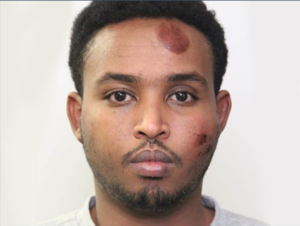
Many who have professionally worried, as did former Department of Homeland Security Secretary Jeh Johnson, that violent jihadists might illegally cross the United States’ southern border are often sanctimoniously challenged with this: “Name a single U.S. border-crossing immigrant asylum-seeker who ever committed a terrorist attack.”
Introducing Abdulahi Hasan Sharif of Somalia.
In 2011, Sharif had himself smuggled from Somalia through Brazil and Central America. Then he entered the United States over the Mexico-California border and claimed asylum. Sharif went on to Canada, where he allegedly conducted a double vehicle-ramming and stabbing rampage in 2017 in Edmonton, Alberta, that severely injured a police officer and four other people. He was carrying an Islamic State flag in one of the ramming vehicles.
Those who paid attention to this case were too few and far between ever to mention Sharif a year ago when President Trump provoked a denialist media backlash by claiming the border was vulnerable to violent jihadists migrating from distant Muslim-majority countries.
 The 32-year-old Sharif is now on public trial in Canada, facing 11 counts of attempted murder, aggravated assault, and dangerous driving. While he occupies a consequential homeland security pedestal of first border-crosser to conduct a jihadi attack in North America, his backstory remains largely unexcavated for learnable lessons to U.S. homeland security. That may or may not change in the coming weeks of a trial.
The 32-year-old Sharif is now on public trial in Canada, facing 11 counts of attempted murder, aggravated assault, and dangerous driving. While he occupies a consequential homeland security pedestal of first border-crosser to conduct a jihadi attack in North America, his backstory remains largely unexcavated for learnable lessons to U.S. homeland security. That may or may not change in the coming weeks of a trial.
That Islamic extremists would infiltrate the United States through the southern border is a prospect that professional homeland security authorities have taken seriously since 9/11. Agencies have long invested in countering the perceived border threat. For instance, Immigration and Customs Enforcement’s Homeland Security Investigations agents are deployed throughout Latin America to disrupt smuggling networks that specialize in transporting foreign citizens from Muslim-majority countries such as Somalia into the United States.
The government labels such migrants “special interest aliens” so they can be flagged to ostensibly undergo enhanced security screenings, such as threat assessment interviews, to which Spanish-speaking people are not subject. As I said during recent field reporting on the migrant trails in Panama and Costa Rica, travelers on U.S. terrorism watch lists have been apprehended at the border or en route in recent years. Perhaps because as many as 20 such suspects a year were caught in various American security nets, none had yet been able to attack in North America – until Sharif.
Trump’s notion that something like this could happen outraged the usual suspects as baseless fearmongering even though dozens of Islamist terrorists successfully snuck over Europe’s external borders while posing as asylum-seeking refugees and these terrorists committed attacks across the continent, such as the devastating attacks in Paris and Brussels. Beyond Sharif, Europe offered much proof of concept.
The full story has yet to be plumbed to learn more about how Sharif got through the American cordon, what his motives and intentions were when he entered California through Mexico, and whether opportunities were missed to interdict him prior to the Edmonton attack.
What We Do and Don’t Know
 On Sept. 30, 2017, Sharif allegedly drove a vehicle into an Edmonton police officer outside Alberta’s Commonwealth Stadium during a local championship soccer match. Sharif got out of the car and allegedly stabbed the officer before running away. An ISIS flag was found inside the car.
On Sept. 30, 2017, Sharif allegedly drove a vehicle into an Edmonton police officer outside Alberta’s Commonwealth Stadium during a local championship soccer match. Sharif got out of the car and allegedly stabbed the officer before running away. An ISIS flag was found inside the car.
A few hours later, Sharif showed up in downtown Edmonton driving a rented U-Haul cube truck, which he allegedly used to run over four citizens, per incitement propaganda from overseas Islamist extremist groups. The truck overturned after a dramatic chase, and Sharif was arrested. All of his victims survived.
It soon emerged in Canadian Press reporting that Sharif had been smuggled to the Mexico-California border on July 12, 2011. According to reporting by Jonny Wakefield of the Edmonton Journal, Sharif left Somalia in 2008 and traveled through Kenya, Tanzania, Zambia, Namibia, and Angola before flying to Brazil. (See interactive route map here.) Once in Brazil, Sharif worked at a chicken-processing plant before hiring smugglers to help him continue on to Mexico.
Sharif crossed over from Tijuana to the San Ysidro Port of Entry and claimed asylum. For reasons unknown, U.S. immigration Judge Carmene Depaolo in San Diego, only a month or so later, ordered Sharif to be deported to Somalia instead of granting him asylum. Was Sharif caught lying? Did investigators find derogatory intelligence about him somewhere? Or did Sharif abandon his asylum claim so he could be legally clear to seek status in Canada?
Whatever the case, deportation never happened because no civil authority in Somalia had developed enough to accept deportees from the United States. And because various U.S. court rulings and policies didn’t allow for such stateless people to be indefinitely detained, Sharif was released on an order of supervision. He was supposed to report to ICE regularly but failed to show up on Jan. 24, 2012, because he was in Canada by then, according to Wakefield’s reporting.
Wakefield learned Sharif traveled to Buffalo, New York, and with help from a refugee support group called Vive La Casa, he crossed into Fort Erie, Ontario, on Jan. 9, 2012, and filed a refugee claim that was granted later that year. Canadian immigration officials said database checks uncovered no information about Sharif that raised red flags, a usual finding with Somalis because no records exist on most citizens in that anarchic country. Likewise, Wakefield cited ICE saying Sharif had been found to have “no criminal history,” records of which would not exist.
Within 36 months of entering Canada, though, in 2015, Sharif was on the radar of Canadian intelligence agencies for espousing extremist Islamist views that included genocidal beliefs related to Islamist teachings. The RCMP’s Integrated National Security Enforcement Team found cause to interview Sharif that year. Assistant Commissioner Marlin Degrand told the Toronto Star there was insufficient evidence to charge him at the time.
Questions Worth Asking and Answering
- How thoroughly did ICE screen Sharif when he was in custody after crossing the U.S. border?
- Did any intelligence failures occur in which Sharif’s background, motives, and connections to U.S.-designated terrorist groups could have been discovered?
- What became of Sharif’s American asylum claim?
- Did Canada’s immigration services know about Sharif’s deportation order and seek information about that or the fact that Sharif was violating his supervised release terms when he entered Canada?
- Sharif spelled his name differently on his Canadian documents than on U.S. documents. Did this matter in some way?
- Given that Somalis generally had no government-issued identification of any sort in 2011, how did Sharif obtain the identification documents and visas necessary to clear various customs checkpoints during his journey from Africa to Brazil?
- When did Sharif radicalize? Was it before he entered California in 2011 or when Canadian intelligence flagged him for espousing genocidal beliefs in 2015?
One U.S. Committee Demanded an Investigation
In October 2018, during its final hours under Republican control, the House Oversight and Reform Committee’s Rep. Trey Gowdy, R-S.C., issued a letter formally requesting that DHS’s Office of Inspector General investigate the Sharif case because “it appears there has been no comprehensive study of the incident.” There’s been no word on whether DHS OIG ever took up the committee’s request.
The committee wanted to know, for instance, how well DHS was vetting special interest aliens for potential terrorism connections (in line with ICE policy to do so), how often such migrants committed asylum fraud and were prosecuted, and how many were released early on bonds before they could undergo threat assessment interviews.
The committee cited a 2011 OIG report (the same year Sharif crossed into California) and a follow-up 2018 OIG report that showed ICE was neither screening nor checking databases for all aliens from countries of national security concern, which would include Somalia.
“The Committee is deeply concerned the vulnerabilities existing in 2011, which allowed this individual to enter, be released, and transit through the U.S. may still exist today,” Gowdy wrote.
What Next?
Alberta prosecutors never charged Sharif under terrorism statutes. Thanks to issues of relevance, it seems unlikely the trial in Edmonton will reveal the kind of information pertinent to American national security and, perhaps, not even to Canadian security.
Prosecutors will be interested mainly in proving that Sharif was behind the wheel of the two vehicles and was the one who stabbed the police officer. A publication ban has blanketed the proceedings, preventing local journalists from reporting anything not in actual court testimony.
The most certain way for America to get the information it needs to protect and serve is for DHS OIG to go forward on the House committee’s request for investigation — or, of course, a full-court investigation by one of our country’s leading media outlets.
Yet no one should expect any coverage of this case from American media, probably because writing about Sharif would require them to emphatically acknowledge a terrorist actually did cross the border and attack. Not to mention that Trump, after all the media ridicule, was correct in saying that potential terrorists have crossed that border and could again.









